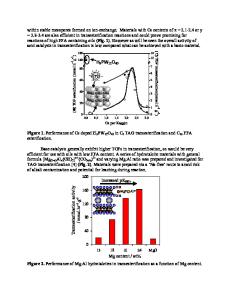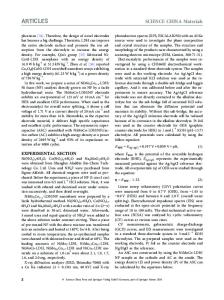Facile synthesis of hierarchical porous carbon/MnO composites for supercapacitor electrode materials
- PDF / 2,421,565 Bytes
- 9 Pages / 595.276 x 790.866 pts Page_size
- 42 Downloads / 513 Views
Facile synthesis of hierarchical porous carbon/MnO composites for supercapacitor electrode materials Guangxu Huang1,3,4 · Weiwei Kang2 · Qianhao Geng1 · Quanrun Liu1 · Baolin Xing1,5 · Chuanxiang Zhang1,3,4 · Bin Duan6 · Wenwen Wang1 Received: 2 January 2018 / Accepted: 17 April 2018 © Springer Science+Business Media, LLC, part of Springer Nature 2018
Abstract The hierarchical porous carbon/MnO composites were prepared from the homogenous mixture of potassium humate and manganese nitrate via one-step carbonization at 700 °C. Manganese nitrate in precursors has a synergistic catalysis effect with potassium element on the pore forming, also leads to an increased oxygen content of as-prepared composite. The PH-Mn-0.1 displays a hierarchical porosity with a moderate surface area of 776 m2 g−1 and total pore volume of 0.487 cm3 g−1, and MnO nanoparticles were uniformly deposited on the porous carbon matrix with a Mn content of 6.7 wt%. When used as electrode material for two-electrode symmetric supercapacitor, the PH-Mn-0.1 delivers higher volumetric capacitance of 276 F cm−3 at a current density of 50 mA g−1, consisting of pseudocapacitance related to MnO nanoparticles and electric double layer capacitance, a maximum energy density of 7.45 Wh kg−1 and low electrochemical resistance. Moreover, the PH-Mn-0.1 shows an enhanced rate capability due to its improved wettability, and novel cycle performance with an increasing specific capacitance during the 1000 charge–discharge cycles at 2500 mA g−1.
1 Introduction Supercapacitors have been regarded as an advanced energy storage device to meet the urgent need for efficient, clean and sustainable sources of energy, and attracted tremendous attentions due to their excellent capacitive performance including high power density, rapid charge–discharge ability, good rate performance and ultra-long cycle life [1–4]. * Guangxu Huang [email protected] * Chuanxiang Zhang [email protected] 1
College of Chemistry and Chemical Engineering, Henan Polytechnic University, Jiaozuo 454003, China
2
School of Chemistry and Chemical Engineering, Southeast University, Nanjing 211189, China
3
Collaborative Innovation Center of Coal Work Safety of Henan Province, Jiaozuo 454003, China
4
Henan Key Laboratory of Coal Green Conversion, Jiaozuo 454003, China
5
Henan Province Industrial Technology Research Institute of Resources and Materials, Zhengzhou University, Zhengzhou 450001, China
6
Do-Fluoride Chemicals Co., Ltd, Jiaozuo 454150, China
Supercapacitors can be classified into two types according to their charge-storage mechanism, electrical double-layer capacitors (EDLCs) and pseudocapacitors, and their electrochemical performances are strongly dependent on the electrode materials used [5–7]. In general, carbon materials are usually used as EDLCs’s electrode materials and transition metal oxides or conducting polymers are used for pseudocapacitors [8]. Carbon materials for EDLCs exhibit excellent reversibility and stability yet relatively lower capacitance, which limits the
Data Loading...











